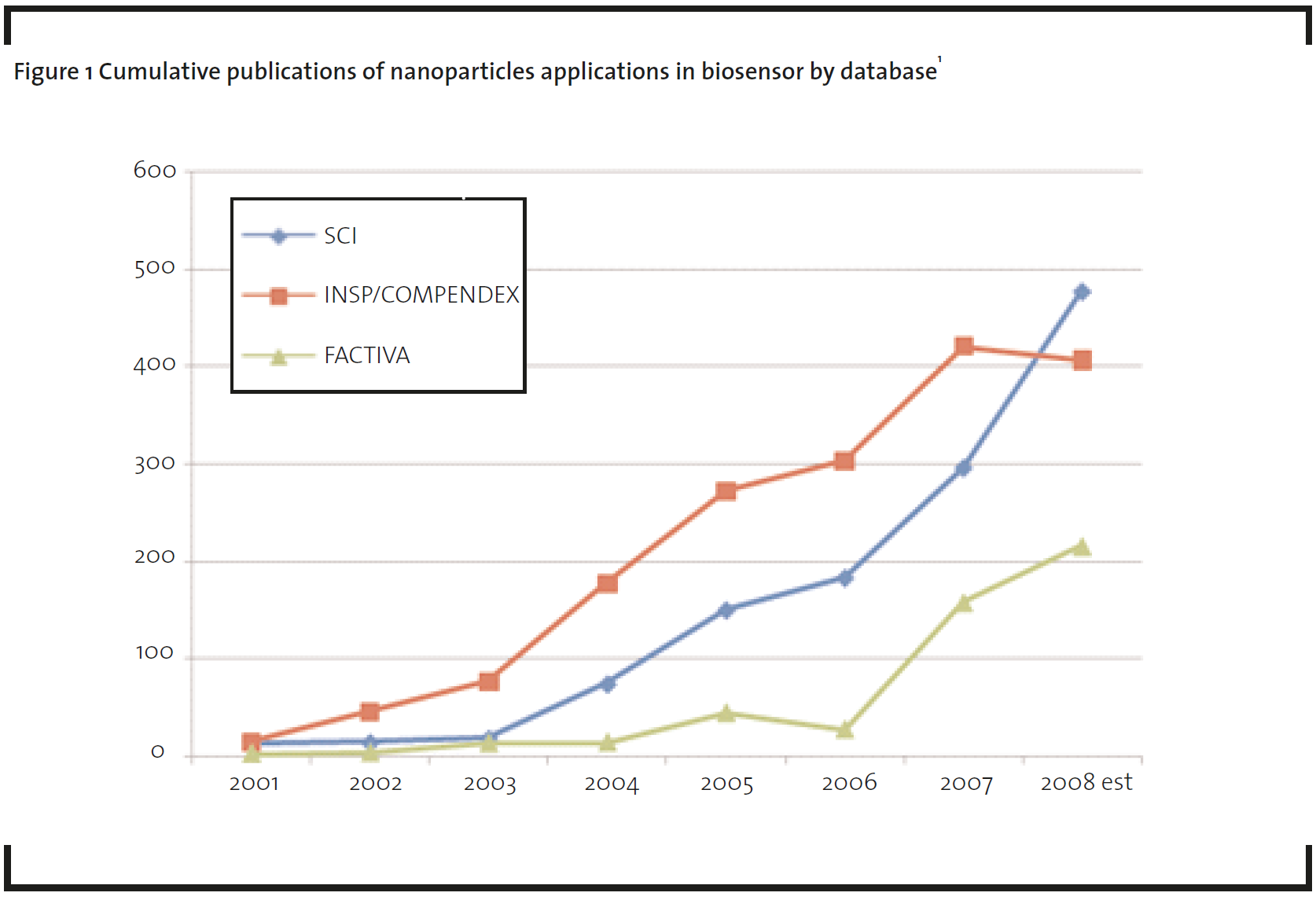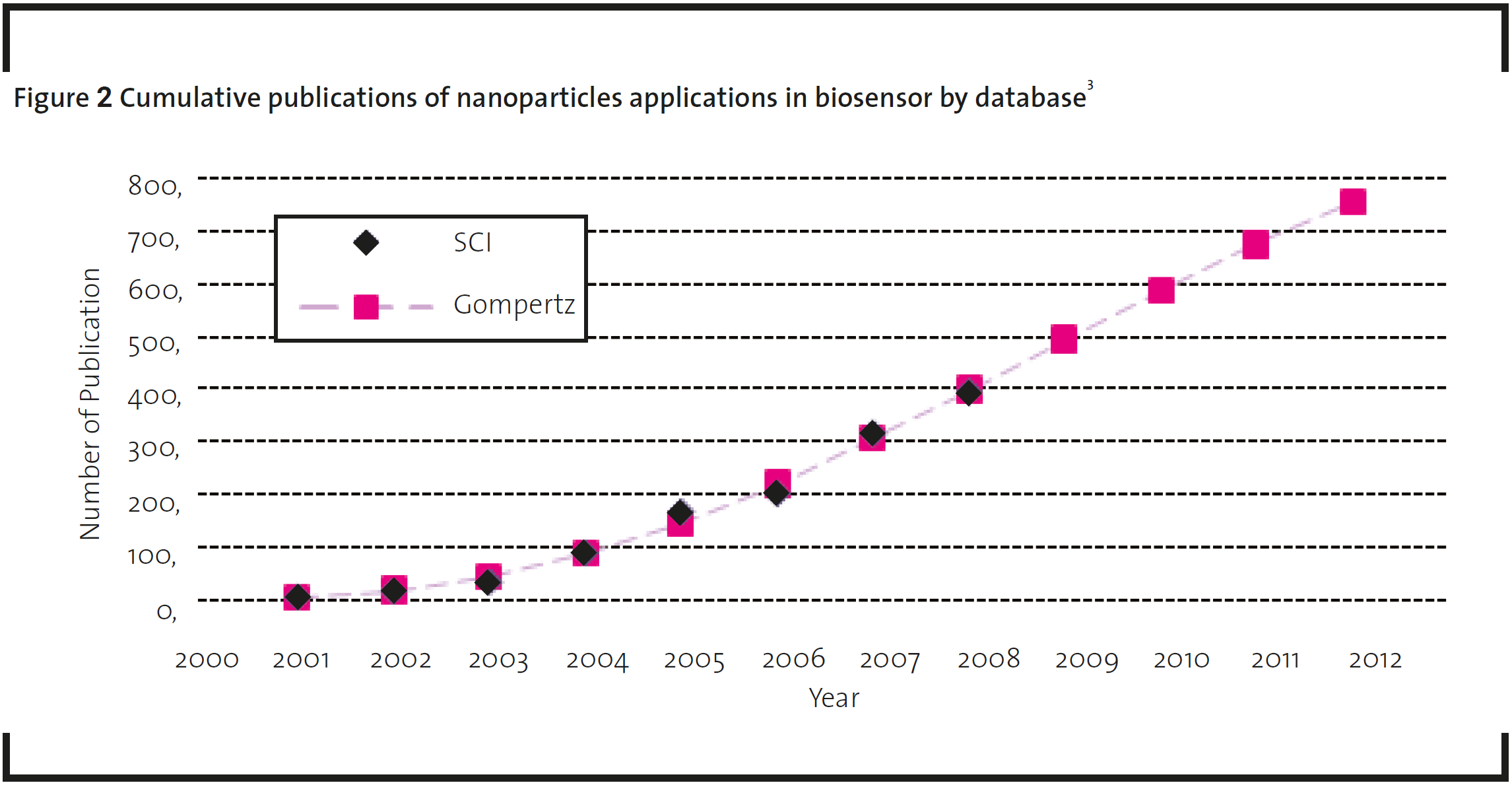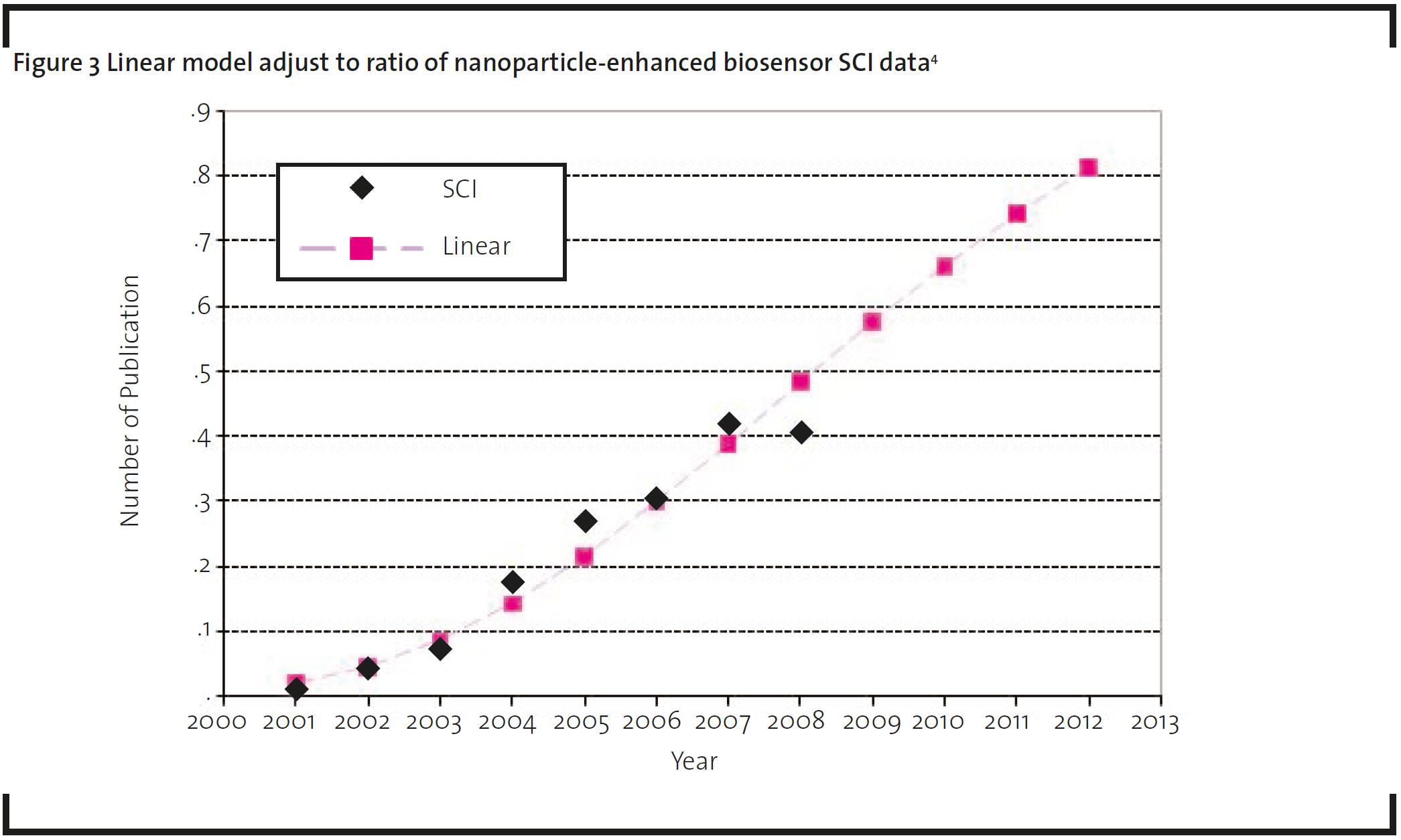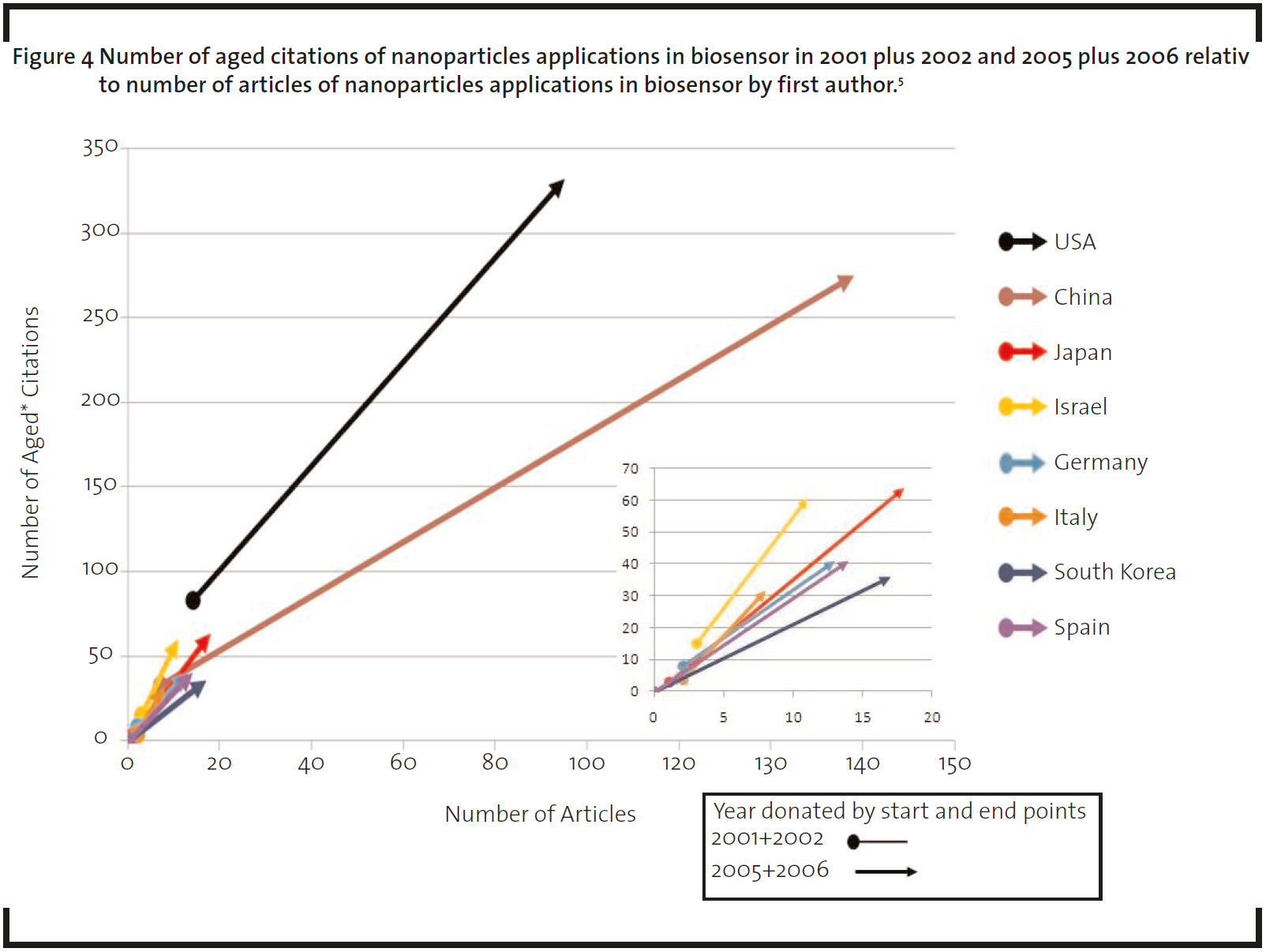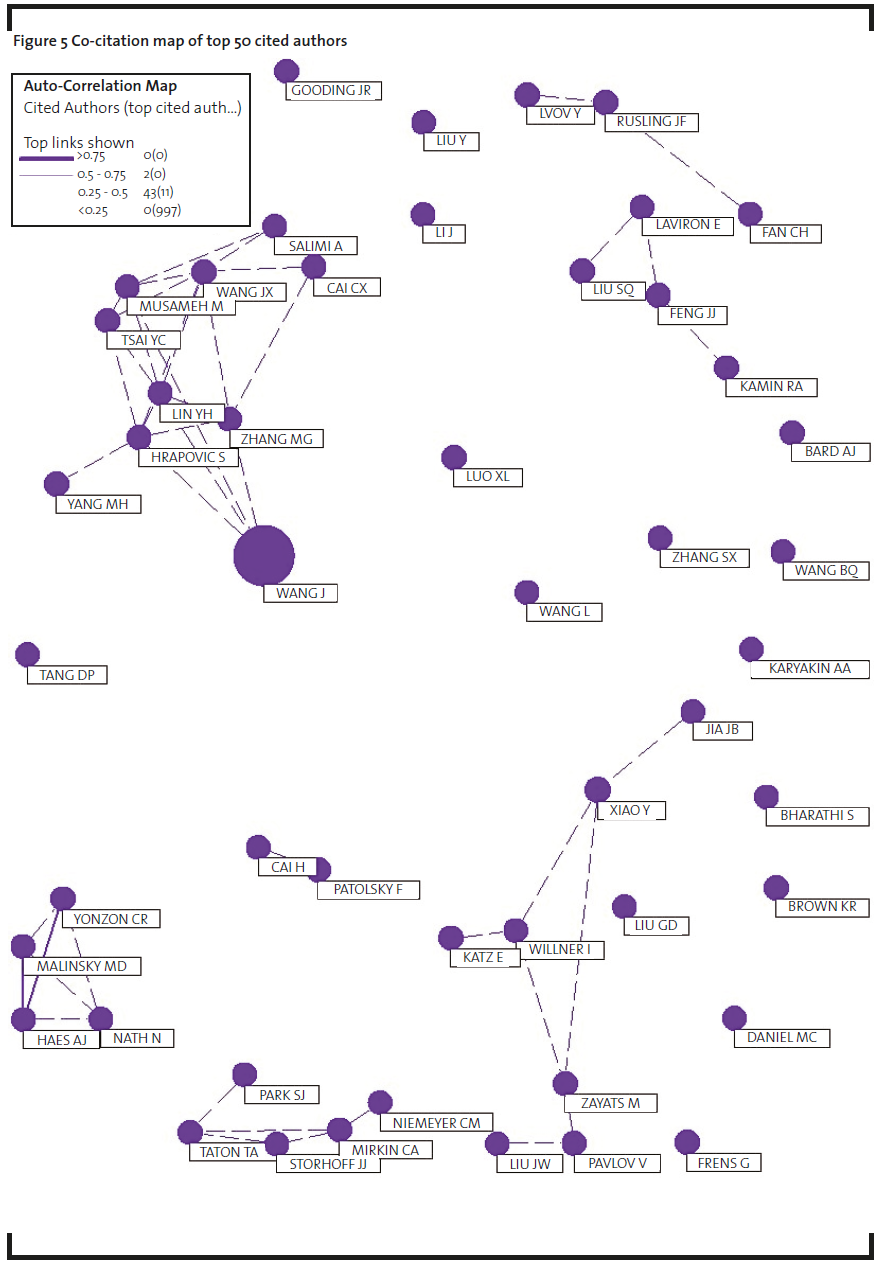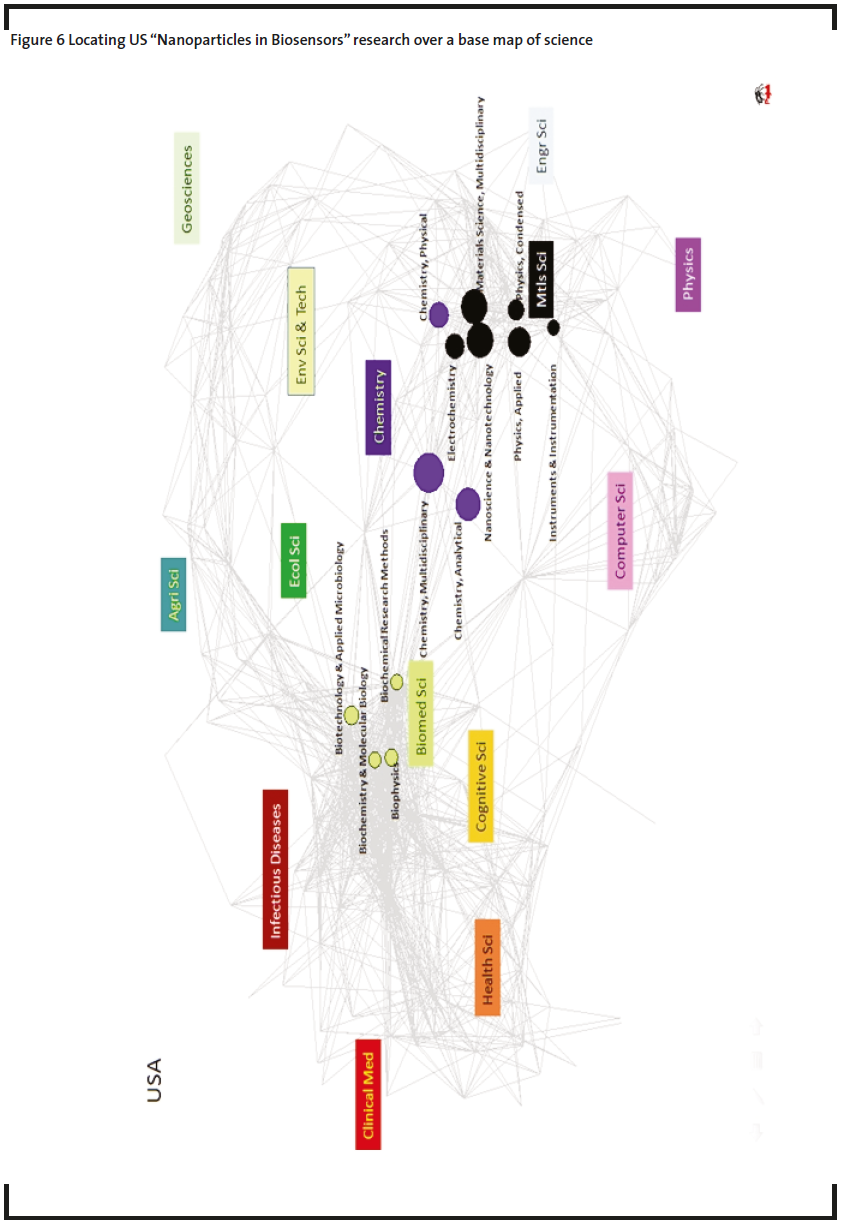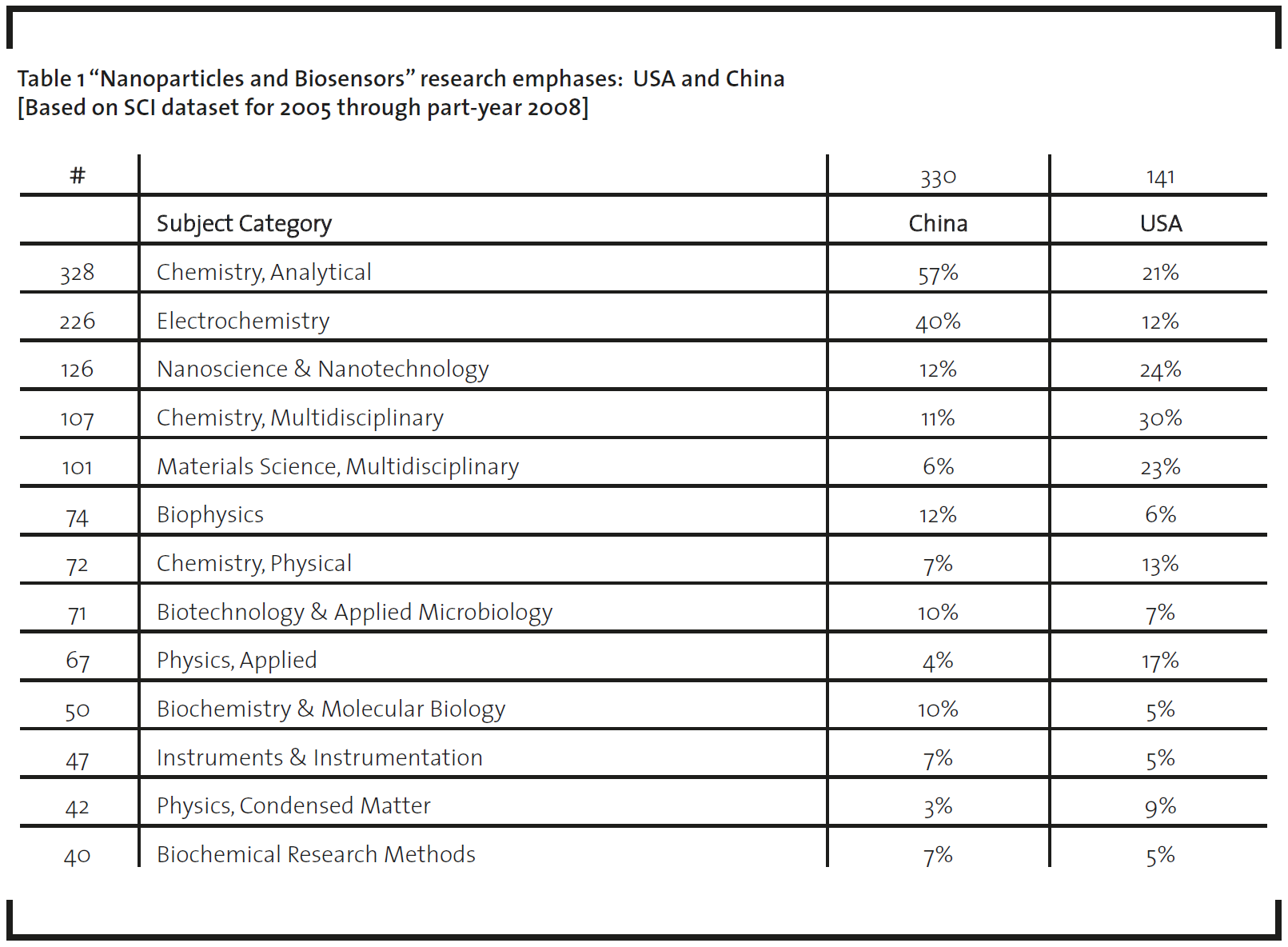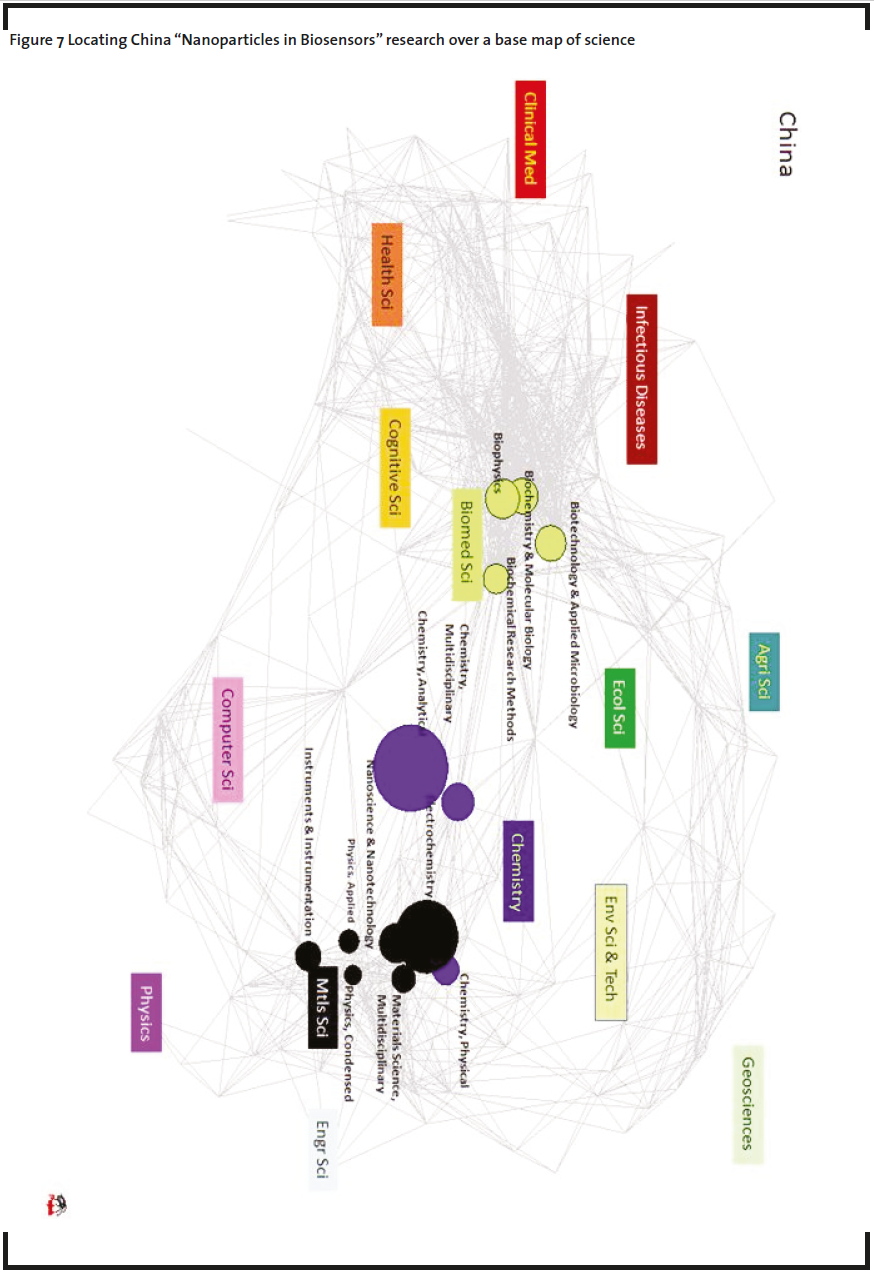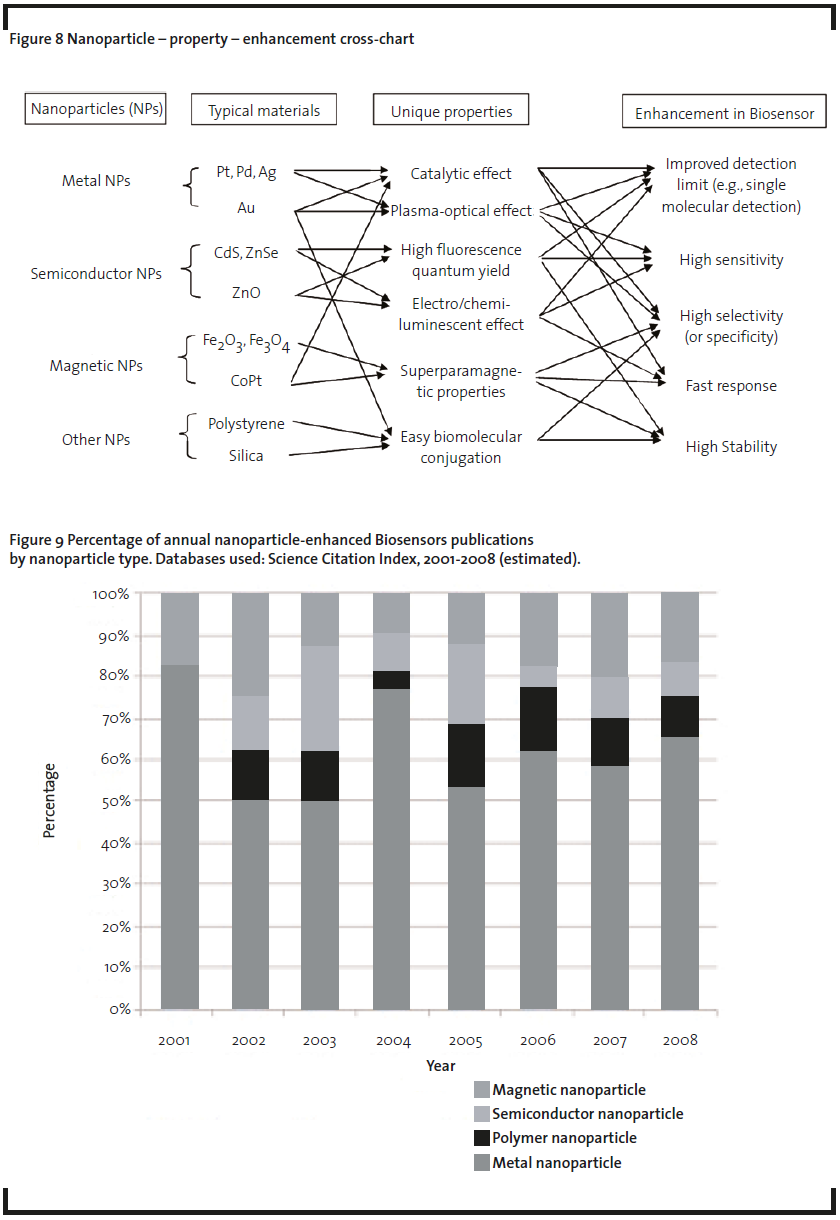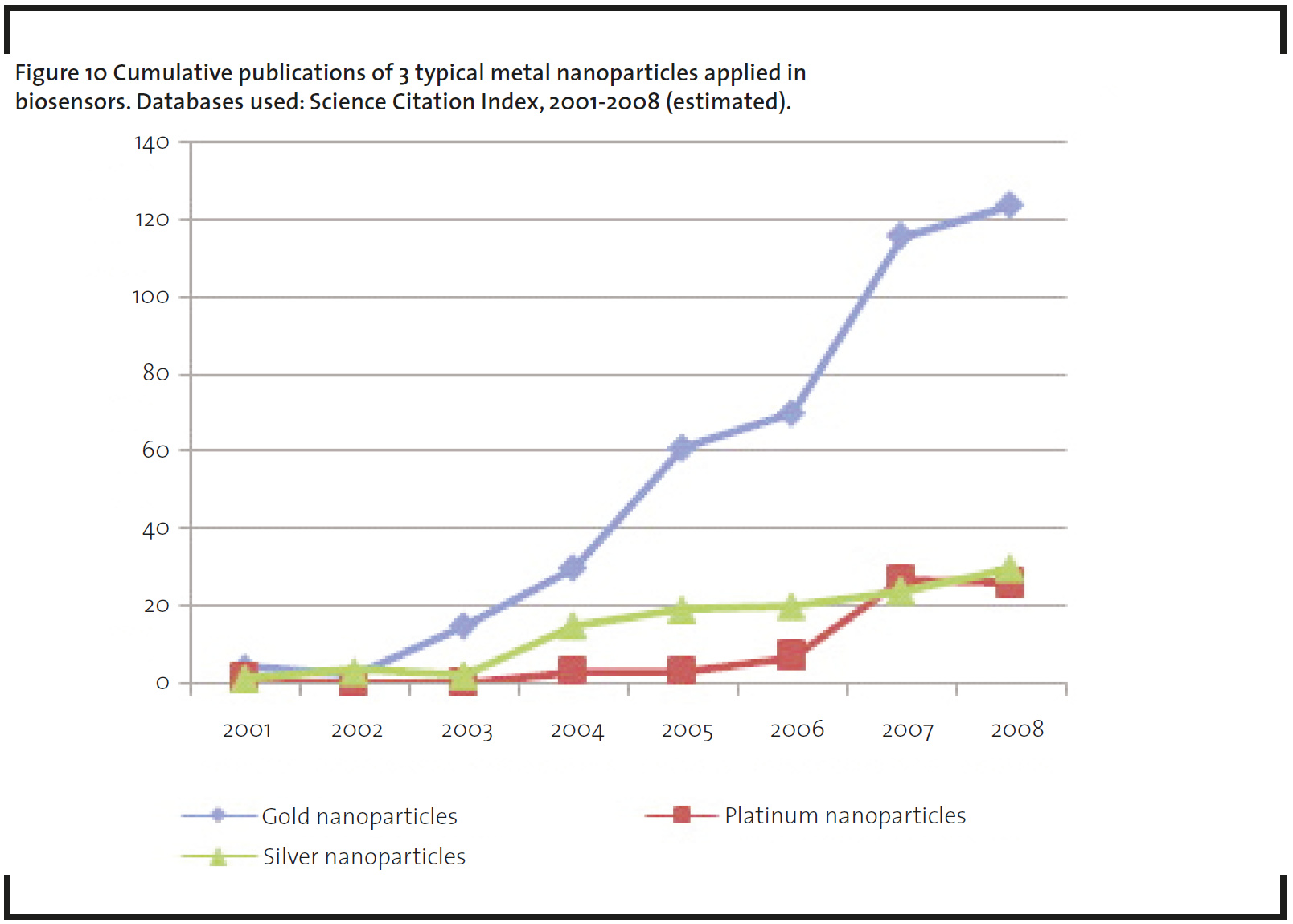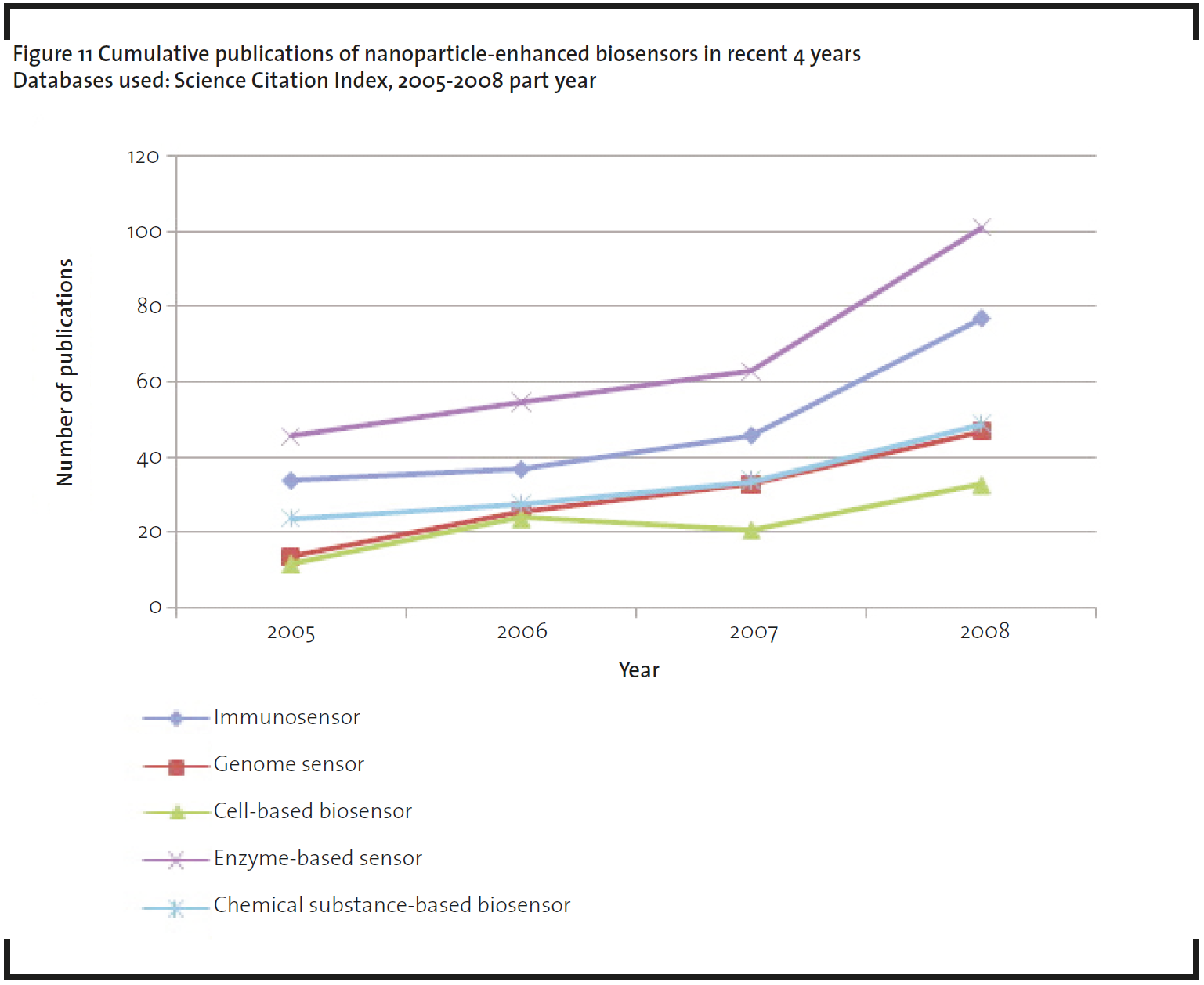Identifying the emerging roles of nanoparticles in biosensors
Abstract
This paper profiles R&D on the application of nanoparticles in biosensors and explores potential application development pathways. The analysis uses a dataset of nanotechnology publication records for the time period 2001 through 2008 (part year) extracted from the Science Citation Index. It focuses on emergent research activities in the most recent years. Bibliometric analyses are employed to ascertain R&D trends and research networks for key biosensors. Growth models are fit to forecast the technological trend for nanoparticle-enhanced biosensor research activity. In addition, a combination of quantity (publication) and quality (citation) analysis for nanoparticle-enhanced biosensors helps position the leading countries in this research field. Science overlay mapping shows different emphases of nanoparticle-enhanced bio sensor research between the US and China, the leading countries. Recent studies suggest that nano-enhanced biosensors show promise for gains in stability, sensitivity, selectivity, and accuracy -for both direct and indirect detection. This paper demonstrates how bibliometric analyses can help anticipate emerging technology development and application potential.
Introduction
Nanotechnology is playing an increasingly important role in the development of sensors. Biosensors represent an especially exciting opportunity for high-impact applications benefiting from “nano” attributes. A biosensor is a device that combines a biological recognition element with a physical or chemical transducer to detect a biological analyte. In general, a biosensor consists of three components: the biological recognition element, the transducer, and signal processing electronics. Nanomaterials can contribute in either the bio-recognition element or the transducer, or both, of a biosensor. The effective biorecognition area, i.e. the area actually interacting with the analyte, is one of the important parameters that determines the sensitivity of a biosensor. Nanomaterials, especially nanoparticles, provide a promising way to increase the bio-recognition area (Khanna, 2008),because the high surface to volume ratio of nanoparticles provides a large number of sites available for molecular interactions (Kim et al., 2004).
In recent years, a wide variety of nanoparticles with different properties have found broad application in biosensors. Because of their small physical size, nanoparticles present unique chemical, physical, and electronic properties that are different from those of bulk materials (Luo et al., 2006), and improved and new biosensors are designed benefiting from these novel attributes. Functional nanoparticles bound to biological molecules (e.g. peptides, proteins, nucleic acids) have been developed for use in biosensors to detect and amplify various (e.g. electronic, optical, and magnetic) signals (Chen, 2004). Most recent studies show that biosensors composed with nanoparticles do take on rapid, sensitive, accurate, and stable measurements, which offers exciting new opportunities for the development of bio sensing capabilities. Nowadays, nanoparticle-enhanced biosensors show significant development. Researchers tend to integrate nanoparticles into the materials used for biosensor construction in order to improve the performance of the system in both existing and potential sensing applications.
Analyzing R&D development trends and relationships for nano-enhanced biosensors can help business decision-makers take best advantage of emerging opportunities (Porter et al., 1991). Although nanoparticle-enhanced biosensors have been researched and affirmed to provide remarkable functional improvements, few studies have tried to systematically characterize the roles of nanoparticles in enhancing bio sensor functionality (Shipway,2008). Our research questions about nano-enhanced biosensors R&D are:
- What are the R&D trends?
- Which countries lead the nano-enhanced biosensors R&D?
- Which fields are engaged in this research?
- What are the emerging roles of nanoparticles in biosensors?
- Which nanoparticles offer the greatest potential for commercial applications?
Approach and data
We employ bibliometric analyses to ascertain R&D trends and research networks for nanoparticle-enhanced biosensors. Bibliometric analysis is a set of tools for extracting information from large databases looking for patterns and explained reasons for apparently unstructured behavior (Daim, 2005). Bibliometric analysis can play important roles in pursuing chemical business opportunities from three aspects. The first is technology forecasting. After getting historical data from authoritative databases, we can adjust these bibliometric data using an S-curve as a way to fit the technological growth process (Daim, 2006), analyzing research trends and identifying emerging areas of technology. Secondly, bibliometric methods can help determine the technology life cycle position and gauge its maturity level. Martino (2003) presents bibliometric analysis dividing the data in five categories. As he described, when the technological development is at the basic research stage, the Science Citation Index (SCI) nicely represents that literature. When the technological development reaches the applied research stage, the technological literature is well represented by the Engineering Index (EI) literature (for certain technologies). When development reaches the experimental development phase, patent documentation is a good reflection. When the development reaches the application stage, Newspaper Abstracts depict activity patterns. At last, bibliometrics can investigate information through the use of different indicators such as publications, cited references, occurrences of words, phrases, citations, co-citations, authorship and related characteristics that may extract hidden patterns from structured data, presenting the whole picture of research networks and relationships (Watts et al., 2001).
The datasets used in these bibliometric studies come from global nanotechnology publications for the time period 2001through 2008 (part year) extracted from different databases: SCI, Inspec, Compendex, and Factiva. This paper focuses on SCI data for intensive study to capture the emergent research activities, especially those prominent in the most recent 4 years. The SCI dataset of publications draws upon the definition of nanotechnology and the data-cleaning methods developed by a Georgia Tech group. Our basic nano search locates abstract records containing “nano*” or any of 7 modular term sets, as discussed by Porter et al. (2008). Within the resulting dataset (of some 500,000 publication abstracts), we then search for those specifically discussing “biosensors,” and “nanoparticles”. Besides these basic search terms, we add other terms like specific categories of biosensor (such as glucose, cholesterol, enzyme, DNA, genome, hydrogen-peroxide, alcohol, nitrate, amino acid, protein chip, DNA array, immunoassay, sandwich assay, competitive assay, etc.) and variants of nanoparticles (such as Ag, Au, Pt, Cds, Pbs, ZnO, SiO2, polystyrene, quantum dots, metal, semiconductor, polymer, etc.). Using this approach, 1,400 publication records were drawn from SCI to create a dataset for the 2001-2008 (mid-year) time period. At the same time, we also set up two other datasets drawn from the Inspec & Compendex databases with 1,715 records, and from Factiva with 489 records. However, the search method for these later datasets is much simpler than that used for the SCI dataset, just using basic search terms of “biosensor” and “nanoparticles”.
Results
Trend analyses
We begin by showing a trend line based on the cumulative number of publications by each of the three datasets (Figure 1). We are trying to find out the development status of nanoparticle enhanced biosensors. The sharp upward trend in articles relating nanoparticles to biosensors shows their increasingly important role .Examining these three growth curves, we find that 2004 is the key point for both the SCI and Inspec & Compendex data series. At about that time, the basic research and the more applied research on nanoparticle enhanced biosensors accelerated into a steeper rate of growth. In comparison, the publication counts of Factiva, reflecting broader business and general public attention, started to increase more steeply in 2007. This suggests that the popular business application of nanoparticles in biosensors lags basic and applied research by about three years.
What is likely to happen in the near future? The last data point for the INSP/Compendex series is estimated because our data reflect only about half of the expected complete 2008 tally. That said, we still note that this point indicates a possible slight decline in applied research on the topic. On the other hand, the increasing rate of publications for SCI in the most recent two years suggests that a further expansion of applied R&D could be anticipated. So, those interested in tracking this emerging technology would want to monitor developments quite closely in the coming years to ascertain the development pattern.
In order to gain a richer perspective on the technology life cycle position and maturity level for nanoparticle-enhanced biosensors, we extrapolate the R&D trends.2 Figure 2 gives one result of trend analyses of publications indexed by SCI through the year 2012. Bibliometric data can be modeled using an S-curve as a way to fit the technological growth process. Here, we choose a Gompertz Model to fit the data with a high R2 coefficient of 0.99. It suggests that steep growth could continue over the next few years. Similarly, trend analyses for the INSPEC & Compendex datasets also follows an increasing trend over the next 4 years (not shown here). According to the results of our trend extrapolation, we estimate that there is still a long time, likely several years or longer, for basic and applied research on nanoparticle enhanced biosensors to grow.
The evidence is strong that nanotechnology has recently become one of the most exciting forefront elements in biosensor R&D. In order to identify the position of nanoparticle-enhanced biosensors among all the nanomaterial-enhanced biosensors, this paper partitions the bibliometric data. We separate the publication counts of nanoparticle-enhanced biosensors from those of any nanomaterial-enhanced biosensors. We then establish a ratio between these. The publications of nanoparticle-enhanced biosensors are primarily from the results of searching the terms, “nanoparticle” and “biosensors”. The publications of nanomaterial-enhanced biosensors come from the results of searching the term “nano*” with “biosensors”. Based on these bibliometric data, we again seek to examine the trend and to forecast the technological growth process of nanoparticle-enhanced biosensors using suitable growth models. In Figure 3, a linear model is used to fit the ratio data from SCI for 2001 to 2008 and gives another trend trajectory extended to the year of 2012. Similarly, a linear model fits the data from INSPEC/COMPENDEX quite well (not shown here). According to the results, we estimate that nanoparticle-enhanced biosensors have more potential than other nanomaterial-enhanced biosensors in the next few years, because the value in the year 2012 is still smaller than the limit of “1.” However, to some extent we were concerned by the goodness of fit of the two trend analyses, because the coefficients of determination of these two models are not very high (0.78 and 0.79, respectively).
Those coefficients just affirm the visual appearance – the fit of the line is not so strong in the earlier years; however, it is quite close in more recent years.
National comparisons based on publication and citation activity
As an emerging field, there has been much interest in the leading countries in research on nanoparticle-enhanced biosensors. This paper not only compares the numbers of publications, but also focuses on the quality and influence of countries in this research field. Citations, as measured by the number of times a paper has been cited, are used here to gauge the level of quality, or impact, of the publications of a country. [This is an imperfect measure, of course, but it is widely accepted as a reasonable indicator that other researchers find worthwhile research knowledge therein (Van,1988).] The particular analytical method used in this paper focuses on the country location of the affiliation of the first author of the publication. The first author’s country is used to assign citation numbers to that country. This focus on the first author is designed to preclude duplicating citation counts.
Another method to be pointed out is that we employ a simple aging practice based on dividing the citations in a given year by the number of years of opportunity to be cited. This is because citations are difficult to evaluate over time. Earlier papers have more occasions to receive citations than do more recent papers (Youtie et al., 2008). As for our dataset of SCI, the most recent year is the mid-year of 2008; thus in 2001, papers have 6.5 years of opportunity to attract citations relative to the end-point of our dataset. So the number of citations to papers published in that year is divided by 6.5. Similarly, in 2002, the number of citations should be divided by 5.5; the number 2006 citations is divided by 1.5; and so forth. So, “aged citations” gives us a metric to help gauge change in nations’ research publications impact over time. Again, this is not a precision measure, but it provides for viable comparison.
In order to make results more robust, we combine the tallies for two-year periods. To reflect the earlier time period, we add 2001 and 2002 together, and compare with the corresponding number for 2005 and 2006 combined. We use 2005-06 to allow a few years for papers to accrue citations. Figure 4 shows the results. A trend line connects the results for (2001 + 2002) to those for (2005 + 2006). We first consider location along the X axis, which reflects publication counts, and find that, in the early time period, the USA is the leader, although the publication counts are modest with 14. However, by the later period, China has taken over the lead in publishing on nanoparticles in biosensors with 158. The Y axis of Figure 4 shows the citations received by those papers, adjusted by the years available since publication in which to be cited. Looking at the starting and the ending points of the lines, we find the US was highest in 2001-02 citation intensity and it remains the leader in the 2005-06 period.
The steeper the slope of the line connecting these two points, the greater the quality orientation of the country has been increasing. From Figure 4, we can find that the US has the steepest slope, suggesting that its nanoparticle-enhanced research receives the greatest attention by researchers. As noted, China is also a leading country in research publication; here we see that Chinese publications also receive increasing citations. Israel, Italy, and Japan have far fewer publications and citations than does China (see the insert of Figure 4). However, the steep slope of their lines relative to China suggests that their papers have relatively higher impact. Germany, Spain, and South Korea are also important players in the research on nanoparticle-enhanced biosensors. So any competitive technical intelligence (“CTI”) endeavors would also want to monitor their research initiatives.
Exploring multidisciplinary aspects of nanoparticle-enhanced biosensor research
“Nano” research is highly multidisciplinary (National Science and Technology Council,1999; Eto, 2003; Loveridge et al., 2008; Roco, 2008; Porter and Youtie, under submission). That said, there is considerable discourse as to which fields are importantly involved and the extent to which research knowledge is actively shared among them (Roco and Bainbridge, 2003; Meyer, 2006). We have found that visualizations of the research fields involved help one gain perspective on the activity.
We also examine the citations from a different point of view. Most highly cited authors (top 50) in our SCI dataset from 2001 through 2008 are mapped via the help of VantagePoint software [see www.theVantagePoint.com] in Figure 5. The size of the node reflects the number of citations, and the strength of the links shown represents the degree of association based on co-citation (the extent to which papers reference both of a pair of authors). It should be noticed that no link between two nodes doesn’t mean zero co citations, just fewer co-citations . Proximity in these Multi-Dimensional Scaling (MDS) maps also suggests relationship, but not as definitely as do the path-erasing based links (lines). Location along the axes has no inherent meaning.
The clustering seen in Figure 5 suggests possible concentrations in the cited literature. We examined in which journals the different highly co-cited authors published most heavily. We then associate those journals with their SCI subject categories, noting four particularly prominent ones:
- Chemistry, Analytical: with Wang J (Arizona State Univ) as the centrally-cited author
- Materials Science, Multidisciplinary: a group at Northwestern University, including Mirkin CA, Yonzon CR, Malinsky MD , and Haes AJ
- Electrochemistry: Bard AJ (University of Texas, Austin); Liu SQ (Nanjing University); Rusling JF (University of Connecticut); Lvov Y (Louisiana Tech Univ)
- Biotechnology: Willner I and Xiao Y (The Hebrew Univ of Jerusalem); Liu GD (Pacific Northwest National Lab); Mirkin CA (Northwestern University); Nie SM and Bao G (Georgia Institute of Technology).
Science mapping is emerging as a specialty in its own right (Chen, 2003; Boyack et al., 2005). We have been developing a “science overlay mapping” approach to locate particular research sets on a base science map (Leydesdorff and Rafols, forthcoming; Rafols and Meyer, forthcoming). This approach uses the Subject Categories that Web of Science assigns to journals. For a set of publications indexed by Web of Science (in this case, by SCI, which is part of Web of Science), we locate that research by the journals in which it appears. Figures 6 and 7 do that for subsets of the “nanoparticles and biosensors” research papers, which are based on SCI dataset for 2005 through part-year 2008 in order to focus on the emergent characters of recent 4 years. The base map reflects the 175 Subject Categories shown by the background intersecting arcs among them. The Subject Categories are then grouped into “macro-disciplines” using a form of factor analysis (Principal Components Analysis) based on the degree of co-citation of the Subject Categories in a large sample of articles indexed by Web of Science (Porter and Rafols, forthcoming). Those macro-disciplines become the labels in the figure. The “nanoparticles in biosensors” research concentrations appear as nodes on this map.
These science overlay maps particularly help us answer two questions: which research fields are engaged? And how similar is the approach of different players? In this case, we choose to focus on national comparisons. We only show two of the leading countries active in this research arena – the US and China. Some observations include:
- Nanoparticles in Biosensors research involves a very extensive range of research fields
- That research is centered in Materials Sciences and Chemistry
- The research also involves a number of Biomedical Sciences
The Chinese and American research patterns are largely similar – both engage the same broad swath of research fields. But Chinese and American research emphases are not identical (Table 1 shows significant variations, particularly in chemical specialties).
Table 1 tabulates the leading Subject Categories represented by Chinese and American publications in this area for 2005-08. On the left, one sees the number of publications associated with each Subject Category. At the top is the number of publications by China and by the USA. The percentages are taken of the national totals. So, for example, 57% of China’s articles indexed by SCI for this search set(nanoparticles and biosensors) are associated with Analytical Chemistry journals and another 40% are linked to Electrochemistry [We note that the column percentages total over 100%; that is because Web of Science associates some journals (~39%) with more than one Subject Category.]. So, the Chinese research, in comparison to the American, emphasizes Chemistry more heavily. Conversely, notice that American articles are considerably more apt to entail Physics sub-areas than are the Chinese. Discerning such differences (and pursuing their implications) can be vital to proactive business management.
Comparing different types of nanoparticles involved in biosensor enhancement
Reviewing recent studies, we find that many kinds of nanoparticles have been widely used in biosensors. Here, we group nanoparticles into four families -metal nanoparticles, semiconductor nanoparticles, magnetic nanoparticles, and all other types (including polymer nanoparticles, silica nanoparticles, and so on). All these nanoparticles can be used in biosensors, as long as the particle surface is modified with specific functional groups. Since different families of nanoparticles, and sometimes nanoparticles of the same family, can play different roles in biosensor systems, we attempt to identify the most representative properties taken on by different nanoparticles, either in a group or individually. In Figure 8, we summarize the detailed ties from the most frequently researched nanoparticles to their unique properties, and to their possible enhancement of biosensing. Figure 8 reveals the extremely promising prospects of specific nanoparticles in designing new and improved biosensors by using their unique chemical and physical properties.
Our search results show that biosensors composed with nanoparticles do purport to provide advantages in their sensitivity, stability, accuracy, selectivity, and so on. For instance, improved accuracy and stability of biosensors were demonstrated by using nanoparticles as the solid support and carrier of biological components, such as proteins and DNA (Lynch et al., 2007). This improvement benefits from the small physical size of nanoparticles, which minimizes the conformational and activity change of the biological components. In addition, biosensors with improved detection limits and selectivity have been developed by making use of the exceptional catalytic effect of Pt and Au nanoparticles (Luo et al., 2006). Furthermore, biosensors capable of highly sensitive and stable detection of multiple cancer markers were enabled by the high fluorescent quantum yield and enhanced photostability of semiconductor nanoparticles such as CdS and CdSe quantum dots (Medintz et al., 2005). We mention that many polymer nanoparticles (e.g. polystyrene) offer not only direct bioconjugation processes, but also promising biocompatibility. Therefore, we expect the polymer family of nanoparticles to play increasing roles in biosensing applications.
An important trend in current research is using composite nanoparticles with combined properties of polymer, semiconductor, and metal nanoparticles for multifunctional applications. Composite nanoparticles are mainly in the form of core-shell structures. Heavily researched ones include silver-polystyrene particles (Wu et al., 2003) and magnetite-dextran particles (Pankhurst et al., 2003).
In terms of percentage of the aforementioned four kinds (metal, semiconductor, magnetic, polymer) of nanoparticles, metal nanoparticles dominate (Figure 9). Before 2002,only metal and magnetic nanoparticles were investigated for biosensor enhancement. Although semiconductor and polymer nanoparticles were employed to enhance the functions of biosensor systems later, these three kinds of nanoparticles are still relatively^minor components of this research domain. To probe a level deeper, we identified that metal nanoparticles constitute a big family, including Pt, Ag, Au, Pd, Cu nanoparticles and so on. This could be a major reason for its high profile in nanoparticle-enhanced biosensors. Turning to the publications counts of typical metal nanoparticles applied in biosensors (Figure 10), we conclude that gold (Au) nanoparticles are the most frequently used. The gold nanoparticles publications count has kept increasing from 2001 to 2008. However, the other two metal nanoparticles, platinum and silver, are only becoming popular in recent years. Noticeably, platinum nanoparticles appear to be an emerging nanoparticle which is increasingly popular since 2007 in constructing biosensors. Due to high surface free energy, gold nanoparticles can adsorb biomolecules strongly and play an important role in the immobilization of biomolecules for biosensor construction (Cai et al., 2001). In addition, the combination of the catalytic properties of gold nanoparticles with the specificity of biomolecular interactions can result in the construction of highly sensitive and selective sensor systems (Xian et al., 2005). Furthermore, gold nanoparticles have been shown integrated with carbon nanotubes to form nano hybrids to modify biosensors with improved indirect detection of enzymes (Cui et al., 2008).
As for the prominent research fields of nanoparticle-enhanced biosensors, we selected five kinds of biosensors based on the biological components used for bio-recognition in the sensing scheme. In order to capture the character of this research, we focus on their publications numbers in our SCI dataset during most recent 4 years (2005 through 2008 part year). Figure 11 shows that the publications counts of these 5 nanoparticle-enhanced biosensors are increasing over the years. Enzyme-based biosensors are at the top followed by immunosensors, chemical substance-based biosensors, genome sensors, and organism and cell based biosensors.
We present these data to suggest to technology analysts and managers the potential to generate valuable CTI. Again, we reiterate that engagement of technical experts is essential to identify the nuances and implications of such empirical information.
Discussion
This paper has examined R&D on nanoparticle-enhanced biosensors and employed bibliometric analyses as a means to help forecast R&D trends and identify the emerging nanoparticle roles in biosensors. According to the results of the trend growth models, the R&D activities appear likely to increase over the next few years. Moreover, nanoparticles show greater potential to improve the performance of biosensors than do other nanomaterials.
In addition, a combination of quantity (publication) and quality (citation) analysis for nanoparticle-enhanced biosensors helps position the leading countries in this research field. Science overlay mapping helps us see the different emphases of nanoparticle-enhanced biosensors research between the US and China. We noted the potential complementarity in Chinese chemistry and US physics emphases in this R&D. R&D managers might well want to extend such analyses to profile the research emphases of particular organizations. By identifying particular specializations and research strengths, they can identify potential technology development partners. Such research out reach is becoming increasingly essential as “Open Innovation” becomes increasingly important (Chesbrough, 2006; Huston and Sakkab, 2006). This is especially so in today’s difficult economy.
Nanoparticle-enhanced biosensors present a highly cross-disciplinary research arena. This suggests value in exploring the relationships further. Is research concentrated in particular Subject Categories being fully utilized by researchers in other domains? What is the cooperative research network? For instance, are there conferences to bring together the biomedical researchers with the chemists, the materials scientists, and the physicists, to share cutting edge knowledge that could come to bear on nano enhancement of various biosensors? For the technology manager, what can you do to facilitate cross-field and cross-institutional research knowledge transfer? Our perspective, based on these bibliometric analyses, is that this field is ripe for stimulated research knowledge exchange. The variety of nanoparticles, multiple functions, and diverse applications suggest that R&D managers should actively reach out and exploit cross area results.
Researchers incorporate nanoparticles into biosensors to improve the performance of existing and potential sensing applications. We analyzed the increasing focus on specific functions of nanoparticles and their ties to promising enhancement in biosensors. These specific functions include catalytic, plasma-optical, quantum, electro/chemiluminescent, and superparamagnetic effects. One type of nanoparticle can play different roles in different biosensor systems, and it can also play more than one role in the same biosensor system. Different types of nanoparticle enhanced biosensors analyzed include enzyme based biosensors, immunosensors, chemical substance-based biosensors, genome sensors, and cell-based biosensors. We identified gold nanoparticles as especially promising for biosensor enhancement and probed their applications in various biosensors using specific or combined functions they possess. A future course of investigation would involve developing enhanced methods for discerning special functions of different types of nanoparticles in biosensor systems. Our observation that “nano in biosensors” research has become increasingly specific – in terms of particular materials and particular functional gains – is a key indicator that this technology is “emerging” (Watts and Porter, 1997). When research shifts from the general to the specific, this is a key benchmark of maturation.
In closing, we note an important caution. Before basing business decisions on such research profiling and forecasting, one would want to obtain expert opinions by researchers and business people conversant with the topic (Two senior researchers and several others have reviewed and enhanced our analyses). Experts can help build upon these results to suggest additional linkages to related research domains to explore. Experts can also help refine the searches and refocus the inquiry to better understand patterns in specific aspects of this emerging technology.
Acknowledgements
This research was undertaken at Georgia Tech, supported by the National Science Foundation (Award Nos. 0531194 and 0830207); Beijing Institute of Technology, supported by the National Science Foundation of China (Award No. 70639001). Many of the findings in this paper were presented in the 18th International Conference on Management of Technology (IAMOT). The authors also appreciate the valuable suggestions from Prof. Lawrence Bottomley in Chemistry and Prof. Prof. Oliver Brand in Electrical Engineering (both at Georgia Tech).
References
Boyack, K.W., Klavans, R., Börner, K. (2005): Mapping the backbone of science. Scientometrics, 64(3), p. 351-374.
Cai, H., Xu C., He PG., Fang YZ. (2001): Colloid Au-enhanced DNA immobilization for the electrochemical detection of sequence-specific DNA, Journal of electroanalytical chemistry, 510(1), p. 78-85.
Chen, C. (2003): Mapping Scientific Frontiers: The Quest for Knowledge Visualization, Springer, London.
Chen, J.R., Miao YQ., He NY., Wu XH., Li SJ. (2004): Nanotechnology and biosensors, Biotechnology Advances, 22(7), p. 505-518.
Chesbrough, H.W. (2006): Open Innovation: The New Imperative for Creating and Profiting from Technology, Harvard Business School, Cambridge, MA (paperback edition).
Cui, R.J., Huang, H.P., Yin, Z.Z., Gao, D., and Zhu, J.J.(2008):Horseradish peroxidase-functionalized gold nanoparticle label for amplified immuno analysis based on gold nanoparticles/carbon nanotubes hybrids modified biosensor, Biosensors and Bioelectronics, 23(11), p. 1666-1673.
Daim, T.U., Rueda, G.R., Martin, H.T. (2005): Technology forecasting using bibliometric analysis and system dynamics, Technology Management: A Unifying Discipline for Melting the Boundaries, 31(4), p.112-122.
Daim, T.U., Rueda, G.R., Martin H.T., Gerdsri P. (2006): Forecasting emerging technologies: use of bibliometrics and patent analysis, Technological Forecasting & Social Change, 73(8), p. 981-1012.
Eto, H. (2003): Interdisciplinary Information Input and Output of Nano-technology Project, Scientometrics, 58(1),p. 5-33.
Grodal, S., and Grid T. (2008): Cross-Pollination in Science and Technology: Concept Mobility in the Nanobiotechnology Field. Paper presented at the NBER Conference on Emerging Industries: Nanotechnology and Nano Indicators, May, 2008, Cambridge, MA, USA
Huston, L., and Sakkab, N. (2006): Connect and Develop, Harvard Business Review, (3), p. 58-66.
Khanna, V.K. (2008): New-generation nano-engineered biosensors, enabling nanotechnologies and nanomaterials, Sensor Review, 28, p. 39-45.
Kim, T H., Park, I. K., Nah, J. W.,Choi, Y.J., and Cho., C.S. (2004): Galactosylated chitosan/DNA nanoparticles prepared using water-soluble chitosan as a gene carrier, Biomaterials, 25, p. 3783-3792.
Leydesdorff, L., and Rafols, I. (Forthcoming): A Global Map of Science Based on the ISI Subject Categories, Journal of the American Society for Information Science and Technology. Preprint [http://users.fmg.uva.nl/lleydesdorff/ map06/texts/map06.pdf].
Loveridge, D., Dewick, P., and Randles S. (2008): Converging technologies at the nanoscale: The making of a new world? Technology Analysis & Strategic Management, 20(1), p. 29-43.
Luo, X.L., Morrin, A., Killard, A.J., Smyth, M.R. (2006): Application of nanoparticles in electrochemical sensors and biosensors, Electroanalysis, 18(4), p. 319-326.
Lynch, I., Cedervall, T., Lundqvist, M., Cabaleiro-Lago, C., Linse, S. and Dawson K.A. (2007): The nanoparticle–protein complex as a biological entity; a complex fluids and surface science challenge for the 21st century, Advances in Colloid and Interface Science, 134, p. 167-174.
Martino, J.P. (2003): A review of selected recent advances in technological forecasting, Technological Forecasting and Social Change, 70(8), p. 719-733.
Medintz, I.L., Uyeda, H. T., Goldman, E.R., and Mattoussi, H. (2005): Quantum dot bioconjugates for imaging, labelling and sensing, Nature Materials, 4, p. 435-446.
Meyer, M. (2006): What Do We Know About Innovation in Nanotechnology? Some Propositions About an Emerging Field Between Hype and Path-Dependency, Paper presented at the 2006 Technology Transfer Society Conference, September 27-29, Atlanta, Georgia.
National Science and Technology Council (1999): Nanostructure Science and Technology: A Worldwide Study, R.W. Siegel and M.C. Roco. Washington DC, National Science and Technology Council.
Pankhurst, Q.A., J. Connolly, S.K. Jones, and J. Dobson.(2003): Applications of magnetic nanoparticles in biomedicine, Journal of Physics-London-D Applied Physics, 36, p.167- 181.
Porter, A.L., and Rafols, I. (forthcoming): Is science becoming more interdisciplinary? Measuring and mapping six research fields over time, Scientometrics.
Porter, A.L., Roper, A.T., Mason, T. W., Rossini, F.A., and Banks, J., (1991): Forecasting and Management of Technology, John Wiley, New York.
Porter, A L, and Youtie, J., Shapira, P., and Schoeneck, D.J. (under submission) How Interdisciplinary Is Nanotechnology?, Journal of Nanoparticle Research.
Porter, A.L., Youtie, J., Shapira, P., and Schoeneck, D.J. (2008): Refining Search Terms for Nanotechnology, Journal of Nanoparticle Research, 10(5), p. 715-728.
Rafols, I. and Meyer, M .(forthcoming), Diversity and network coherence as indicators of interdisciplinarity: case studies in bionanoscience, Scientometrics.
Roco, M.C., and Bainbridge, W.S.(2003): Converging technologies for improving human performance: Nanotechnology, biotechnology, information technology and cognitive science, Kluwer Academic Publishers, Dordrecht, The Netherlands.
Roco, M.C. (2008): Possibilities for global governance of converging technologies, Journal of Nanoparticle Research, 10(1), p. 11-29.
Shipway, A.N., Katz E., Willner, I. (2000): Nanoparticle Arrays on Surfaces for Electronic, Optical, and Sensor Applications, Chemphyschem, 1(1), p. 18-52.
Van Raan, A.F.J. (Ed.) (1988): Handbook of Quantitative Studies of Science & Technology, North Holland, Dordrecht. See also website: http://www.cwts.nl/
Watts, R.J., Porter, A.L., Newman, N.C.(2001): Innovation forecasting using bibliometrics, Competitive Intelligence Review, 9(4), p. 11-19.
Watts, R.J., and Porter, A.L. (1997): Innovation Forecasting, Technological Forecasting and Social Change, 56, p. 25-47.
Wu, D., Ge, X., Huang, Y., Zhang, Z., and Ye, Q. (2003): Radiation synthesis of silver–polystyrene and cadmium sulfide–polystyrene nanocomposite microspheres, Materials Letters, 57, p. 3549-3553.
Xian, Y.Z., Hu, Y., Liu, F., Xian, Y., Wang H.T., Jin L.T. (2005): Glucose biosensor based on Au nanoparticles-conductive polyaniline nanocomposite, Biosensors and Bioelectronics, 21(10), p. 1996-2000.
Youtie, J., Shapira, P., Porter, A.L. (2008): Nanotechnology publications and citations by leading countries and blocs, Journal of Nanoparticle Research, 10(6), p. 981-986.
